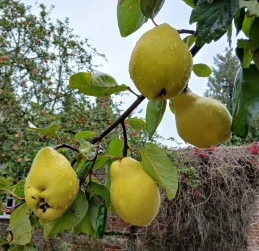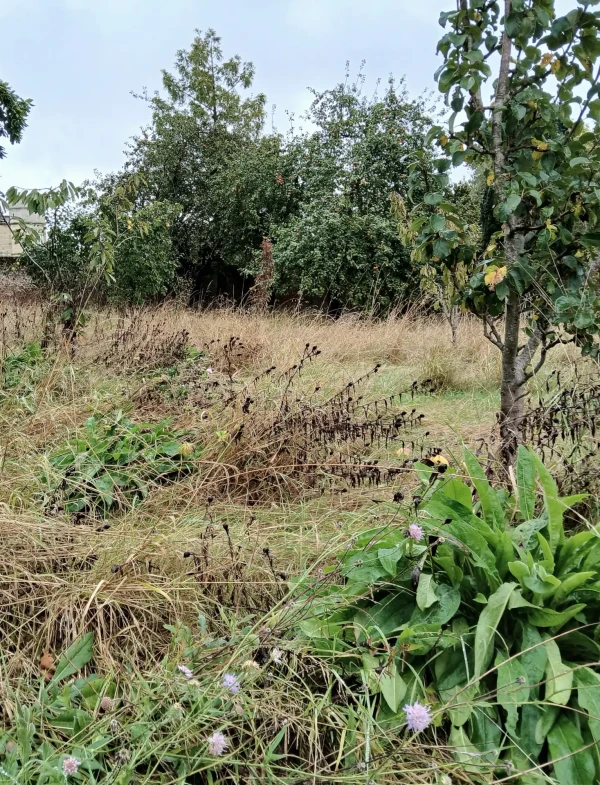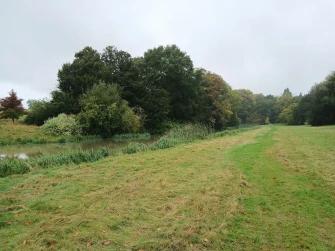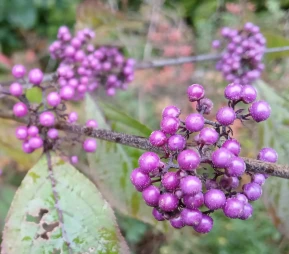Garden Blog - Oct '24
With October now here, the ancient English legend of ‘the Devil and the blackberries’ leaves us poor gardeners are fretting about our juicy fruity charges.
Legend has it that the Archangel Satan and all his rebellious followers were kicked out of heaven by the Archangel Michael on what is now known as Old Michaelmas Day, which is celebrated on October 11th. On falling to Earth, the Devil landed in a blackberry bush, which was undoubtedly rather painful, and so he took his revenge by spitting and peeing on its fruit to spoil them. So you see, we must all ensure that the last of our blackberries are picked by Old Michaelmas Day, before the Devil takes his annual revenge.
While on the subject of fruit, the final lot to be harvested in our Wildflower Orchard are the quinces. Unlike their close relatives, apples and pears, they don’t usually ripen fully in British summers, so need to be left on the tree for as long as possible to enhance their flavour, and harvested when they’ve turned from a light yellow to a golden colour. Depending on the weather, this will usually be during October or November, but they must be harvested before any proper frost, which can spoil them.
Meanwhile, the wildflowers in the eponymous orchard have performed brilliantly this summer, and have now set seed. Therefore, when the weather is dry, we will set about mowing it all down and removing the debris after a couple of days. By leaving the debris for a few days after mowing, more seed will be dispersed before clearing everything away. While clearing the debris each year slowly reduces soil fertility this encourages more wildflowers to establish themselves.
During the course of this year, a much larger wildflower meadow came into existence on the western end of our South Lawn. It was not planned, but the upshot of exceptionally wet weather over the last twelve months. It’s not unusual for the western end of our South Lawn, which runs beside the formal canal, to be affected by drainage issues, as several natural springs emerge in it, but this year was exceptional. Those of you that visited our Snowdrop Sundays in February will have noticed the area roped off due to waterlogging, and it remained soggy for so long that we were unable to mow it conventionally at all this summer, other than a narrow pathway through to the Pleasure Grounds. As a result, we had a lovely display of cuckoo flowers, buttercups, and bugle, amongst others in the grass, along with autumn hawkbit and meadowsweet on the canal banks. The area was also teeming with wildlife, especially butterflies. With winters predicted to get steadily wetter because of climate change, continually fighting a hopeless drainage battle would be pointless. It is better for us to make a positive change and embrace the advantages of what initially seemed like a very negative situation. Therefore, over the coming years, we can let the wildflowers establish themselves more widely in our new meadow, and add others to the mix that like wet soils. This will broaden the spectrum of habitats within our gardens and grounds, give our wildlife a helping hand, and visitors a new feature to admire.
Meanwhile, in our formal gardens, we will be stripping our pots and urns of their summer garb and planting them with hardier souls that are resilient to the rigours of winter. When stripping the pots and urns, tender annuals such as Amaranthus, that we propagate from seed each year, are instantly dispatched to the compost heap. The likes of Heliotrope and Fuchsia, which are tender pernnials, don’t have suitable cutting material at this time of year so are cut hard back, potted up, and kept in the heated glasshouse until the return to growth, at which point they are harvested for cuttings and added to the compost heap, too.
Meanwhile, our large tender Brugmansia shrubs are cut hard back and moved into our heated glasshouse, and herbaceous cannas are lifted, divided, and potted up, before being housed in our frost free polytunnel.
On the October task front, now is also the ideal time not only for planting spring flowering bulbs in the garden, but also those for forcing to decorate our homes in the depths of winter. Narcissi and hyacinths are favourites here, not only for their cheery colour in the darkest days, but also their intoxicating scent. The process of forcing is quite simple. Firstly, with regards to hyacinths, it’s essential to buy what are known as ‘prepared bulbs’, also, you may wish to wear gloves when handling them, as hyacinths can cause skin irritation. For both narcissi and hyacinths, pot them into good multi-purpose compost either singly or in groups, at a depth that leaves their tips just poking through the surface, and water well. After planting, the bulbs need to be kept in the dark and cool, ideally around 9°C, to encourage the development of a good root system. When the bulbs have sprouted with leaves at 5cm or so in length, bring the pots into a cool room to allow them to green up, then move them to their final location to bloom.
Finally, a shrub that looks particularly fine at this time of year is Callicarpa bodinieri var. giraldi, known more commonly as the beauty bush. Native to West and Central China, this medium sized deciduous shrub is perfect for gardens of all size, having small lilac flowers produced in the leaf axils, and dark green leaves that turn purply red in autumn. The piece de resistance however, are the clusters of decorative purple berries in tight clusters in autumn.
Until next month, happy gardening.





